[slideshare id=29739714&doc=nettalksslides-140106132031-phpapp01]
I am leading a #Nettalks Webinar on “Leveraging Social Media to Engagement and Inspire Alumni Networks” at 2 PM EST today. On Monday, I shared a post about some network and strategy concepts. In this post, I’m sharing my slides, resources, and practical engagement tips with a higher purpose. That purpose, of course, is to build a life-long relationship with alumni of your nonprofit’s program or school so that they are a donor and champion for your organization.
Let’s look at some practical examples for engaging and connecting with your Alumni Network on social media channels.
1. Celebrate the Accomplishments of Individuals in Your Alumni Network
This is the type of news sound byte you will typically see in Alumni magazines or that alums (or their parents) might share with your organizations. You want to celebrate their personal, social, or professional accomplishments. Even better if you can tag the individual or do their Twitter handle. In this Twitter example below, the school is also encouraging the alumni network to RT this alum’s accomplishment. Be sure to use compelling photos and other visuals.
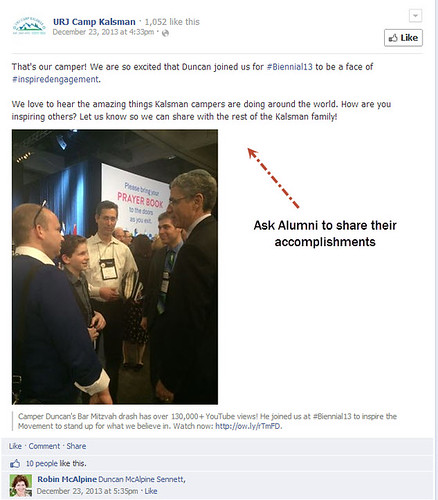
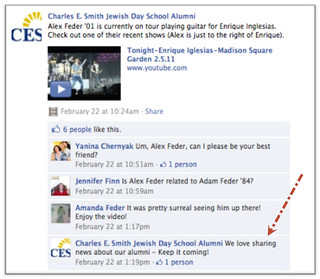
Celebratory interactions should be a consistent part of your engagement and content calendar, so set up systems to capture and share alumni personal, social, and professional news. For example, use Twitter lists to track alums and subscribe to their Facebook updates. You might also consider setting up a Facebook Group just for alumni and encourage them to share this information. Make sure that you good internal system for sharing any updates that might come in through fundraising office or other school connections.
You can also invite Alums to share what they’re up to as part of your engagement strategy on social channels, either as a dedicated post or part of the conversation in the comments.

2. Connect Alumni with Current School Experience
Conversation starters that link alumni to the current school experience can spark tons of engagement. Asking for feedback about how to improve the school experience is also a good technique, as used in the example above is from URJ Camp Kalsman. Notice that the organization’s Facebook administrator hangs out in the comments and makes an effort to respond to each comment by liking or replying. Also, by hanging out a few extra minutes after you post to engage with your alumni network on Facebook sets up a culture of interaction. John Hadyon suggests not calling it posting, but planting seeds. This has an added benefit of increasing your “people talking about” metric which gets the content into more newsfeeds.
Sharing memories from Seminar 2013 at the #icnola reunion! pic.twitter.com/PXdIUl0IIQ
— RamahSeminar (@RamahSeminar) December 24, 2013
Sharing photos from reunions or Alumni meetups on campus is another way to make that connection like this Twitter example above from Ramah Seminar. Notice the the conversation is about the application deadline. The event also had a hashtag which makes it easy for those on Twitter to find and connect. Notice how they were able to connect with alums who were not able to attend the event. Another way to do this might be to highlight a shared school tradition, like “Senior Prank Day” and ask a conversation starter such as “What did you do for senior prank day when you were a senior?”

3. Use Nostalgia (old class photos) to Spark A Trip Down Memory Lane
Nostalgia is much more than mere reminiscing; it’s a warm, fuzzy emotion that we feel when we think about fond memories from our past. In a 2012 study, researchers discovered that nostalgizing helps people relate their past experiences to their present lives in order to make greater meaning of it all. The result can boost their mood and reduce stress. Nostalgia increases feelings of social connectedness to others and makes people feel loved and valued and increases perceptions of social support when people are lonely.
Nostalgia can be a powerful way to engage people in your alumni network to get them reminiscing and reaching out to other classmates that you might not have in your network. The example above, from Shulamuth School for Girls in Brooklyn, received over 70 comments with the conversation being about “where is so and so now” and others providing information their classmates.

Many schools probably have wonderful archival photos – it’s a gold mine for engagement. With old class photos, you can leverage memes like “Throw Back Thursday, like in this example from Reshet Ramah, a network of alumni from across the globe. Don’t like Throw Back Thursday? Make up your own nostalgia meme. How about Flash Back Friday?
4. Engage Alumni in Professional Conversations Related To Their Careers
You can also engage with alumni about their professional work experiences, especially if it is directly connected to your program. This example from Teach for America is a photograph of handwritten thank you note from a student to an TFA alumni thanking them for making a difference. Notice the engagement in the comments, with people tagging each other. You’ll also notice that the comments have many likes and many of those come directly from the Facebook admin for the page.
Maybe of your alums are more likely to be engaged by intellectual conversations about their work related to the degree they earned from your school or program or are just starting their careers and could benefit from professional networking. LinkedIn groups and company pages are a great place to encourage this type of engagement. Here’s an example from the Jewish Education Project.
5. Images, Questions, and Comments Inspire Facebook Engagement
There are several tactical techniques that consistently work on Facebook to inspire engagement. Here’s a brief summary of the tip with a link to the full post with more tips.
- Always Be Commenting – This wisdom comes from Guy Kawasaki and while it isn’t hot off the press, it still holds true as we noticed in the examples above. Guy notes that the ideal ratio of peoples’ comments to your responses is one-to-one. The exception is when there are many comments that are generic such as “Nice!” “Cool!” or “Love it!” Each of these doesn’t require a response, but when comments are more individualistic, jump in and comment back. People want to know that you’re reading your timeline comments and reacting, so the three keys of commenting are: fast (within 24 hours); many (respond to everyone); and often (make commenting core to your Facebook activity). This is a lot of work, but engaging alumni is a lot of work, but the longer-term pay off is worth it. In a recent interview, John Hadyon reinforced this timeless piece of Facebook engagement advice.
- Images Drive Engagement But Choose Wisely: In age of information overload and so many connections, visual content is more attention grabbing. Images work for engagement. But you have to select wisely. The real question for you to answer which images drive better engagement. That question can form the basis of many Facebook experiments. Does posting a stand-alone, self-explanatory image out perform a photo that needs additional explanation in the description? Does a photo showing people doing an activity do better than people posing together? Here some tips on how to improve Facebook engagement with photos.
- Questions Are Powerful Conversation Starters: According to KISSmetrics, questions receive 100% more comments than standard text posts. When it comes to engagement, especially comments, asking a question on Facebook is very effective. What’s most important where to ask that question. According to research, place the question at the end. John Haydon did this pattern analysis of different types of questions that nonprofits ask on Facebook. I transformed it into a brainstorming worksheet if you’re at a loss about what questions to ask on Facebook. Be sure that you test, test, test to see if there are certain types of questions that work best for engaging your alumni. Linking your questions to the school experience, celebrations, nostalgia, and professional conversations are all good ways to get engagement.
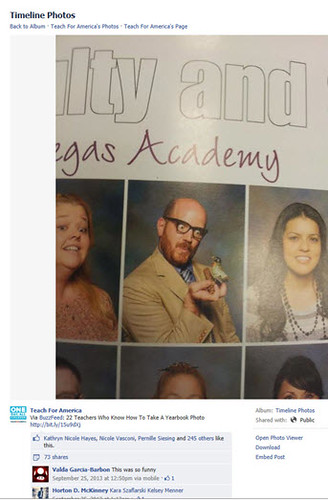
6. Fun, Games, and Giveaways!
Fun is almost always engaging, especially humorous photos, articles, and observations. It has to resonate with your audience and connect back to your school experience. Here’s a great example from Teach for America sharing a funny visual about goofy year-book photos.
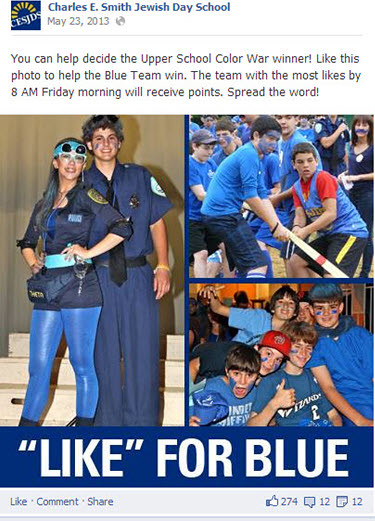
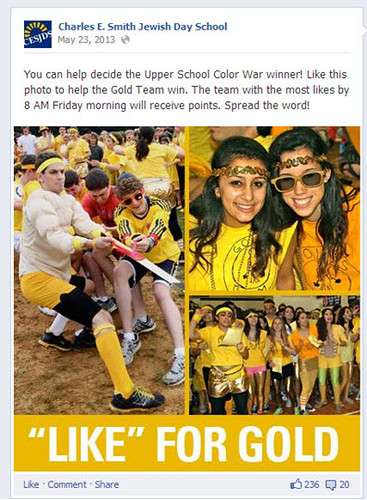
Games are even more engaging. What’s more fun than a color war on Facebook?

And, of course, your alumni network and Facebook fans love free stuff and giveaways. But make them fun too. This is a book giveaway that John Haydon did for my book, Measuring the Networked Nonprofit. It does have a Star Wars theme, but he created a fun caption contest. Here are some tips for games and giveaway contests on Facebook.
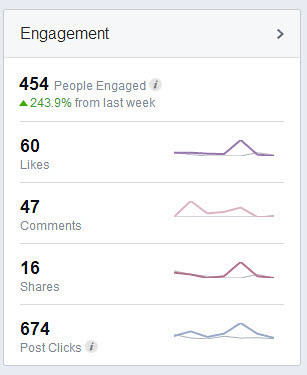
7. Experiment, Measure, Learn, and Revise
The only way your organization will know what conversation starters and content is engaging to your alumni is measure it. It is important to measure along your whole engagement model (see my earlier post). You also need to use measure to improve and I suggest these two ways:
- Watch the “People Talking About This” Metric: The People Talking About This number is publicly displayed on the left sidebar under the number of Likes. This figure is a good top line indicator of whether you are, in fact, engaging your Alumni. You want to watch the number and how it is trending. For an accurate picture, take the People Talking About This number and divide it by the total number of fans. Healthy pages have percentages between 1% and 5% (or more for great interaction). The PTAT metric includes all the following activities that happen on your page over a one-week rolling period:
Liking a page
Posting to a page’s wall
Liking, commenting on or sharing a page post (or other content on a page, like photos, videos or albums)
Answering a question posted
RSVPing to an event
Mentioning a page in a post
Phototagging a page
Liking or sharing a check-in deal
Checking in at a place (if your page has a place merged with it)
More here about that metric and other Facebook metrics you can gather in the Facebook analytics program.
- Do Controlled Experiments To Test for Content Resonance and Engagement: You need to do analysis of your insights per post data on a monthly basis and understand which type of posts, topics, and timing works best for engaging your Alumni. Here’s a great recipe for doing a controlled experiment on Facebook.
Remember, engagement is not a quick fix and takes time and some thought. Most of all, it requires a consistent practice of asking questions, reminiscing, celebrating Alumni and their accomplishments, or connecting Alumni with the school experience. Also keep in mind that engagement is not for the sake of engagement but it has a high purpose – you are leading your alumni down a path towards becoming life long supporters of your organization. Engagement can be that first important step.
What have you discovered about the practical art of social media engagement with a higher purpose?
